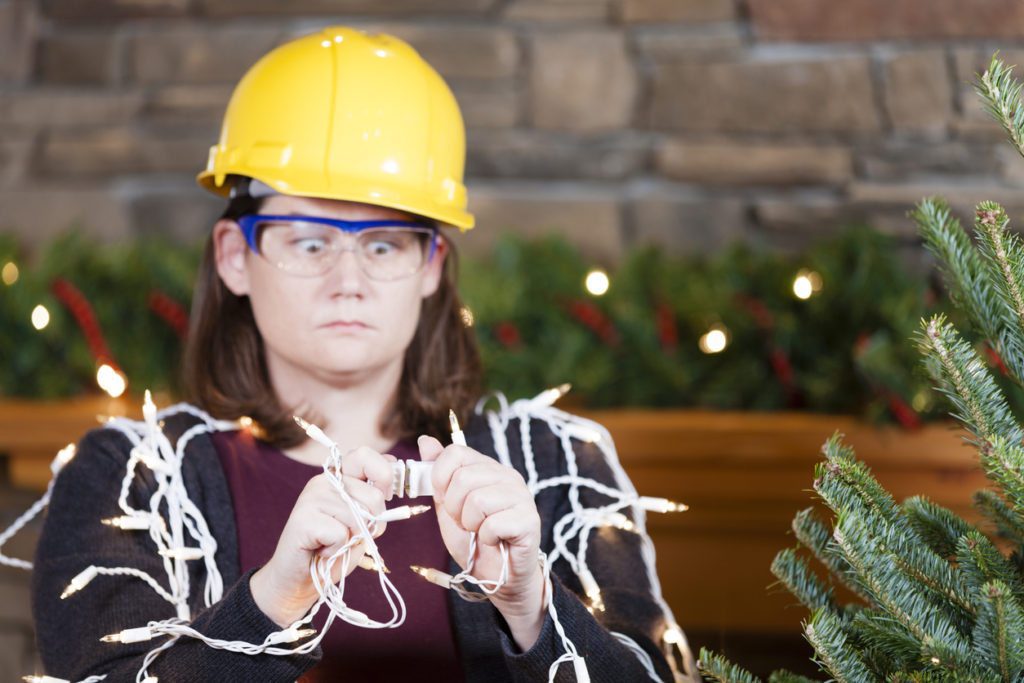Safety Hazards Around the House This Christmas

Holiday safety hazards cause 47,700 home fires annually during December alone, resulting in $554 million in property damage. The top Christmas safety risks include electrical fires from decorative lights, tree fires from dried-out branches, and kitchen accidents during holiday cooking. Here’s how to protect your family and home from the most dangerous holiday hazards.
Fire Hazards
Christmas Tree Fire Prevention
Fires are among the most dangerous holiday safety hazards this time of year, with Christmas trees causing 160 home fires annually. Between space heaters, candles, Christmas trees, fireplaces and cooking, fire hazards increase 300% during the holiday season.
Essential Fire Safety Steps
To avoid holiday fires, double check that all fireplaces are completely out before you go to bed or leave the house. Make sure your tree is watered daily with 1-2 gallons, and turn off all decorative lights when you leave the house for more than 2 hours.
Candle and Alarm Safety
Don’t leave candles lit or near any decorations, and be sure you check all your fire alarms before the holiday season arrives. Don’t wait for the batteries to beep at you to change them every 6 months. If you have monitored smoke detectors, test them with your Security Company, and rest easy knowing the fire department will be dispatched if the smoke detector goes off.
Cord Damage
Electrical Overload Prevention
Holiday safety experts warn that electrical fires increase 34% in December due to overloaded circuits. With so many additional things plugged into your outlets this time of year, it’s easy to have a dangerous cord overload at home.
Safe Cord Management
When wires are pinched, crushed, or damaged, they become fire hazards within 30 minutes of use. The best way to avoid this Christmas safety risk is to keep cords out from under furniture, away from water, and away from anything that might pinch them. Don’t plug more than 3 major appliances into any outlet, and keep everything organized while it’s plugged in.
Vacations and Leaving Home
Home Security During Holiday Travel
Holiday safety during travel requires planning 2-3 weeks ahead. If you’re planning a weekend getaway or a trip to see family for the holidays, ensure your alarm system is armed and doors and windows are locked.
Travel Safety Checklist
Ensure your family and close friends know you’re leaving town, set lights on a timer every 3-4 hours, stop your mail until you get home or have a trusted neighbor collect it daily. If you can, have a neighbor shovel your walks within 24 hours of snowfall.
Smart Home Holiday Security
Smart Home Security Systems provide options for automated lighting schedules, and they can be set up to look natural based on approximate times or time of sundown. Criminals avoid well-lit homes that don’t look empty, reducing break-in risk by 60%. If you want to stay extra connected, you can use wireless IP cameras to monitor your home every 2-4 hours while away.
Decorating Safety
Ladder Safety for Holiday Decorating
Holiday decorating injuries send 5,800 people to emergency rooms each December. If you’re planning on hanging lights this season, inspect your ladder for loose bolts or damaged steps before use.
Rooftop and Outdoor Safety
Make sure you enlist help when decorating icy rooftops with lights, and never decorate in winds over 15 mph. Your holiday safety must come first, no matter how badly you want to have the best-dressed home for the holidays.
Tree Safety
Fresh Tree Maintenance
Real Christmas trees become fire hazards when they lose more than 50% of their needles. Keep them watered with 1 gallon daily for the first week, then 1/2 gallon daily after that.
Tree Stability and Child Safety
Christmas trees tip over and injure 1,000 people annually, so anchor them correctly with a wide, water-filled base. If you plan on decorating with kids in the house, keep glass ornaments and hook ornaments above 4 feet high, and use child-friendly décor along the bottom 2 feet of your tree.
Pet and Child Hazard Prevention
Broken ornaments cause serious damage if swallowed or stepped on. A good holiday safety rule is to keep all décor that’s breakable, heavy over 2 pounds, or sharp out of reach of small kids and pets.
Christmas Dinner
Kitchen Fire Prevention
It’s the best time of the year for good food, but kitchen fires increase 230% on Christmas Day. Never leave burners or ovens unattended for more than 10 minutes when cooking holiday meals.
Child Safety in Holiday Kitchens
If you’re using knives, never keep them within 2 feet of the counter edge where a small child might grab them. Keep all pot handles turned in or back while they’re on the stove so little hands aren’t tempted to reach for them.
Food Safety and Handling
Raw meat should never touch your counters or other food not being cooked, and must be kept below 40°F until cooking. Wash your hands for 20 seconds after handling all food, and know if guests have food allergies to prevent contamination. Keep counters sanitized after each use, and always clean everything within 30 minutes after handling raw turkey or ham.
The holidays are definitely a special time of year, and following these holiday safety practices goes a long way in avoiding the 6 most common seasonal hazards that affect 250,000 families annually.